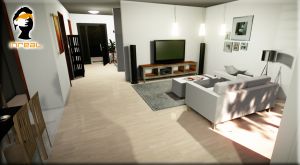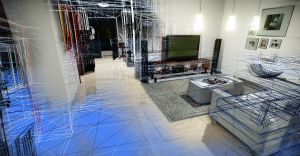Even the most exact construction plan lacks many details and design options. The building owner needs imagination to obtain an idea of the constructed building. Now, the 3D video glasses made by the KIT spin-off “inreal Technologies” provide a true representation in virtual reality. With the help of integrated high-resolution motion sensors, the virtual environment adapts to the natural movement of the head in real time. At the CeBIT, the young entrepreneurs will present their new product at the stand of their partner, Carl Zeiss AG (hall 15, A26).
The inreal terminal is an innovation for use in architecture. Users can “access” their future home prior to construction. The key component of the terminal is a head-mounted display, 3D video glasses with integrated high-resolution motion sensors. They measure the position and movement of the head and, thus, allow for an adaptation of virtual environment in real time. Via tablet control, design wishes, such as changes of the wall color, floor cover, or room layout, can be made immediately. The terminal is advantageous for the client and reduces the architect’s working time during the planning phase.

The terminal, consisting of the 3D video glasses, controller, 3D display, and tablet, may not only be used by architects, but also for other purposes. Any environment can be “modeled” on the computer and “accessed” via the terminal. “The terminal gives the users an authentic feeling of space due to intuitive navigation,” explains Moritz Luck, one of the founders of the spin-off. In the future, the technology shall be developed further for home users.
inreal Technologies was established in 2010 by the KIT students Thomas Schander, Michael Beyhs, and Moritz Luck. In cooperation with the Institute for Information Management in Engineering (IMI), the young entrepreneurs developed their ideas to maturity. For their innovative approach, they were granted a spin-off stipend under the EXIST program by the Federal Ministry of Economics and Technology.
Further information and a video presentation can be found on the website of inreal: http://www.inreal-tech.com/
IT at KIT: This Year’s Highlights
At the CeBIT in Hanover on March 6, 2012, KIT will present current research from information technology and its focuses COMMputation as well as Anthropomatics and Robotics (hall 9, stand G33). Information technology will also be in the focus of KIT’s annual reception on March 22, to which numerous partners from industry and science have been invited. The first German department of informatics will celebrate its 40th anniversary at KIT in autumn.
Information technology at Karlsruhe Institute of Technology is bundled into two focuses. The KIT Focus COMMputation integrates communication and computation for development of devices with capabilities to interact, to perceive their environment, and to adapt to dynamically changing requirements. Researchers from the fields of informatics, electrical engineering, information technology, and economics cooperate to develop new concepts, architectures, methods, tools, and applications for the relevant complex systems.
The KIT Anthropomatics and Robotics Focus intends to improve the quality of life of humans. Using methods of informatics, mechanical engineering, electrical engineering, information technology, social sciences, and humanities, symbiotic systems are developed after the models of human anatomy, motor functions, perception, and behavior. The research topics range from machine intelligence, human-centered robotics, multimodal interaction and robot technology through to industrial robotics.
In close partnership with society, KIT develops solutions for urgent challenges – from climate change, energy transition and sustainable use of natural resources to artificial intelligence, sovereignty and an aging population. As The University in the Helmholtz Association, KIT unites scientific excellence from insight to application-driven research under one roof – and is thus in a unique position to drive this transformation. As a University of Excellence, KIT offers its more than 10,000 employees and 22,800 students outstanding opportunities to shape a sustainable and resilient future. KIT – Science for Impact.

